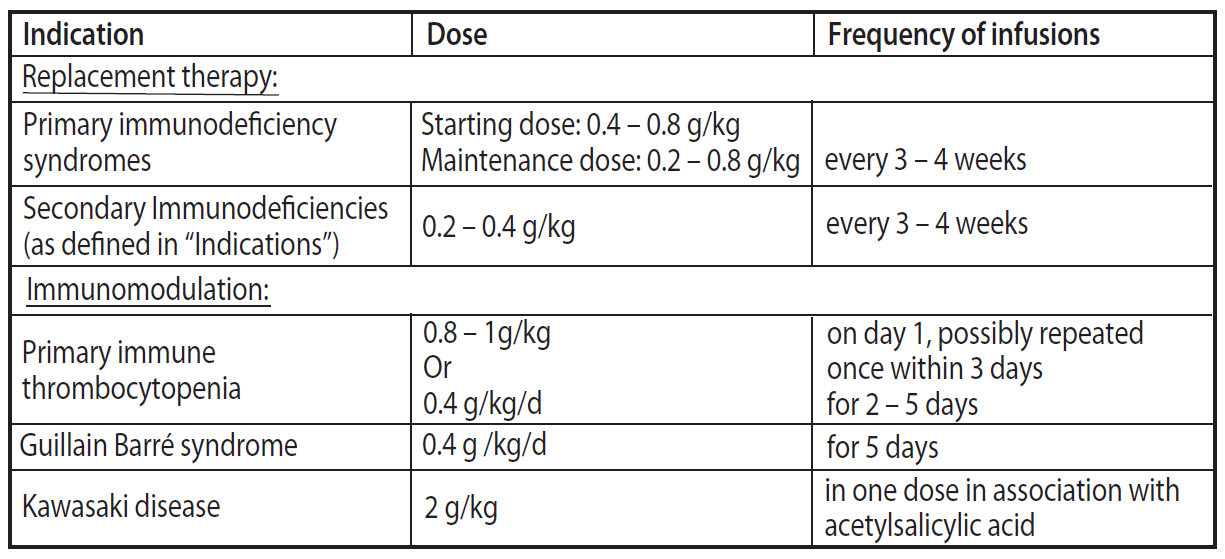Regulatory Information
HSA regulatory responsibility and product classification details
Regulatory Responsibility
Product Classification
Formulation Information
INJECTION
**\[DOSAGE AND ADMINISTRATION\]** IVIg therapy should be initiated and monitored under the supervision of a physician experienced in the treatment of immune system disorders. Posology The dose and dose regimen are dependent on the indication. The dose may need to be individualised for each patient dependent on the clinical response. Dose based on body weight may require adjustment in underweight or overweight patients. The following dose regimens are given as guidance. _Replacement therapy in primary immunodeficiency syndromes_ The dose regimen should achieve a trough level of IgG (measured before the next infusion) of at least 6 g/ L or within the normal reference range for the population age. 3–6 months are required after the initiation of therapy for equilibration (steady-state IgG levels) to occur. The recommended starting dose is 0.4–0.8 g/kg given once followed by at least 0.2g/kg given every 3–4 weeks. The dose required to achieve a trough level of IgG of 6 g/L is of the order of 0.2–0.8 g/kg/month. The dosage interval when steady state has been reached varies from 3–4 weeks. IgG trough levels should be measured and assessed in conjunction with the incidence of infection. To reduce the rate of bacterial infections, it may be necessary to increase the dosage and aim for higher trough levels. _Replacement therapy in secondary immunodeficiencies (as defined in “Indications”)_ The recommended dose is 0.2–0.4 g/kg every 3–4 weeks. IgG trough levels should be measured and assessed in conjunction with the incidence of infection. Dose should be adjusted as necessary to achieve optimal protection against infections, an increase may be necessary in patients with persisting infection; a dose decrease can be considered when the patient remains infection free. _**Immunomodulation in:**_ _Primary immune thrombocytopenia_ There are two alternative treatment schedules: - 0.8–1 g/kg given on day 1; this dose may be repeated once within 3 days. - 0.4 g/kg given daily for 2–5 days. The treatment can be repeated, if relapse occurs. _Guillain Barré syndrome_ 0.4 g/kg/day over 5 days (possible repeat of dosing in case of relapse). _Kawasaki Disease_ 2.0 g/kg should be administered as a single dose. Patients should receive concomitant treatment with acetylsalicylic acid. If the treatment is effective, long-term treatment should be subject to the physician’s discretion based upon the patient response and maintenance response. The dosing and intervals may have to be adapted according to the individual course of the disease. The dosage recommendations are summarised in the following table:  **Method of administration** For Intravenous use. Human normal immunoglobulin should be infused intravenously at an initial rate of 0.01–0.02 mL/kg/min for 30 minutes. See “Adverse Reactions” – _please refer to the Product Insert/Patient Information Leaflet published on HSA for the full drug information_. In case of adverse reaction, either the rate of administration must be reduced or the infusion stopped. If well tolerated, the rate of administration may gradually be increased to a maximum of 0.06 mL/kg/min.
INTRAVENOUS
Medical Information
**\[INDICATIONS\]** Replacement therapy in adults, children, and adolescents (0–18 years) in: - Primary immunodeficiency syndromes (PID) with impaired antibody production - Secondary immunodeficiencies (SID) in patients who suffer from severe or recurrent infections, ineffective antimicrobial treatment and either proven specific antibody failure (PSAF)\* or serum IgG level of 4g/L \\* PSAF= failure to mount at least a 2-fold rise in IgG antibody titre to pneumococcal polysaccharide and polypeptide antigen vaccines Immunomodulation in adults, children and adolescents (0–18 years) in: - Primary immune thrombocytopenia (ITP), in patients at high risk of bleeding or prior to surgery to correct the platelet count - Guillain Barré syndrome - Kawasaki disease (in conjunction with acetylsalicylic acid; see “Dosage and Administration”)
**\[CONTRAINDICATION\]** 1. Patients with history of hypersensitivity to the ingredients of this medicine 2. Patients with history of shock from the ingredients of this medicine 3. Patients with hypersensitivity to immunoglobulins (especially patients with anti-IgA antibodies)
J06BA02
immunoglobulins, normal human, for intravascular adm.
Manufacturer Information
THE REG CONSULTANTS PTE. LTD.
SK Plasma Co.,Ltd.
Active Ingredients
Documents
Package Inserts
IVIG SG PI_200ml.pdf
Approved: April 20, 2023
